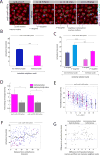Transcriptional Memory in the Drosophila Embryo
- PMID: 26748851
- PMCID: PMC4970865
- DOI: 10.1016/j.cub.2015.11.058
Transcriptional Memory in the Drosophila Embryo
Abstract
Transmission of active transcriptional states from mother to daughter cells has the potential to foster precision in the gene expression programs underlying development. Such transcriptional memory has been specifically proposed to promote rapid reactivation of complex gene expression profiles after successive mitoses in Drosophila development [1]. By monitoring transcription in living Drosophila embryos, we provide the first evidence for transcriptional memory in animal development. We specifically monitored the activities of stochastically expressed transgenes in order to distinguish active and inactive mother cells and the behaviors of their daughter nuclei after mitosis. Quantitative analyses reveal that there is a 4-fold higher probability for rapid reactivation after mitosis when the mother experienced transcription. Moreover, memory nuclei activate transcription twice as fast as neighboring inactive mothers, thus leading to augmented levels of gene expression. We propose that transcriptional memory is a mechanism of precision, which helps coordinate gene activity during embryogenesis.
Copyright © 2016 Elsevier Ltd. All rights reserved.
Figures



Comment in
-
Gene Regulation: Stable Noise.Curr Biol. 2016 Jan 25;26(2):R61-R64. doi: 10.1016/j.cub.2015.12.002. Curr Biol. 2016. PMID: 26811888
Similar articles
-
Mitosis-associated repression in development.Genes Dev. 2016 Jul 1;30(13):1503-8. doi: 10.1101/gad.281188.116. Genes Dev. 2016. PMID: 27401553 Free PMC article.
-
Transcriptional Timers Regulating Mitosis in Early Drosophila Embryos.Cell Rep. 2016 Sep 13;16(11):2793-2801. doi: 10.1016/j.celrep.2016.08.034. Cell Rep. 2016. PMID: 27626650 Free PMC article.
-
The embryo as a laboratory: quantifying transcription in Drosophila.Trends Genet. 2014 Aug;30(8):364-75. doi: 10.1016/j.tig.2014.06.002. Epub 2014 Jul 6. Trends Genet. 2014. PMID: 25005921 Free PMC article. Review.
-
Quantitative imaging of transcription in living Drosophila embryos links polymerase activity to patterning.Curr Biol. 2013 Nov 4;23(21):2140-5. doi: 10.1016/j.cub.2013.08.054. Epub 2013 Oct 17. Curr Biol. 2013. PMID: 24139738 Free PMC article.
-
Combinatorial patterning mechanisms in the Drosophila embryo.Brief Funct Genomic Proteomic. 2009 Jul;8(4):243-9. doi: 10.1093/bfgp/elp026. Epub 2009 Aug 3. Brief Funct Genomic Proteomic. 2009. PMID: 19651703 Review.
Cited by
-
Metabolic transcriptional memory.Mol Metab. 2020 Aug;38:100955. doi: 10.1016/j.molmet.2020.01.019. Epub 2020 Feb 12. Mol Metab. 2020. PMID: 32240621 Free PMC article. Review.
-
Flying the RNA Nest: Drosophila Reveals Novel Insights into the Transcriptome Dynamics of Early Development.J Dev Biol. 2018 Mar 7;6(1):5. doi: 10.3390/jdb6010005. J Dev Biol. 2018. PMID: 29615554 Free PMC article. Review.
-
Establishment and maintenance of heritable chromatin structure during early Drosophila embryogenesis.Elife. 2016 Nov 23;5:e20148. doi: 10.7554/eLife.20148. Elife. 2016. PMID: 27879204 Free PMC article.
-
A mitotic bookmark coordinates transcription and replication.bioRxiv [Preprint]. 2025 Jul 2:2025.06.29.662044. doi: 10.1101/2025.06.29.662044. bioRxiv. 2025. PMID: 40631093 Free PMC article. Preprint.
-
Distinct Roles of Broadly Expressed Repressors Support Dynamic Enhancer Action and Change in Time.Cell Rep. 2019 Jul 23;28(4):855-863.e5. doi: 10.1016/j.celrep.2019.06.063. Cell Rep. 2019. PMID: 31340149 Free PMC article.
References
-
- Porcher A, Abu-Arish A, Huart S, Roelens B, Fradin C, Dostatni N. The time to measure positional information: maternal hunchback is required for the synchrony of the Bicoid transcriptional response at the onset of zygotic transcription. Development. 2010;137:2795–2804. - PubMed
-
- Muramoto T, Müller I, Thomas G, Melvin A, Chubb JR. Methylation of H3K4 Is Required for Inheritance of Active Transcriptional States. Current Biology. 2010;20:397–406. - PubMed
-
- Sigal A, Milo R, Cohen A, Geva-Zatorsky N, Klein Y, Liron Y, Rosenfeld N, Danon T, Perzov N, Alon U. Variability and memory of protein levels in human cells. Nature. 2006;444:643–646. - PubMed
Publication types
MeSH terms
Substances
Grants and funding
LinkOut - more resources
Full Text Sources
Other Literature Sources
Molecular Biology Databases

